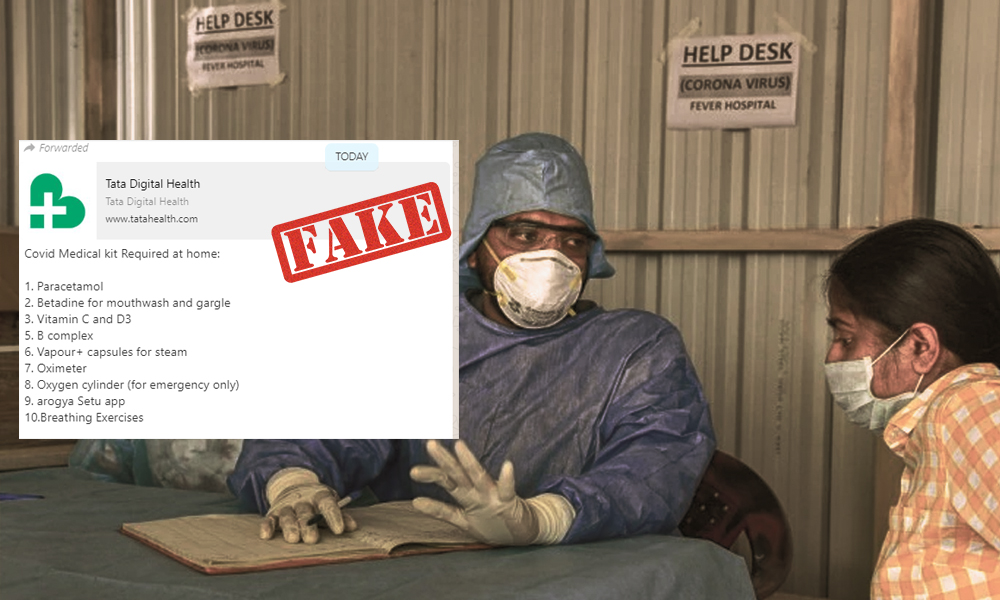
Image credit: India Today (Representational Image)
Fact Check: Viral WhatsApp Forward Talking About Covid Medical Kit Required At Home Not Issued By Tata Health
India, 15 Jun 2020 2:22 PM GMT | Updated 15 Jun 2020 2:34 PM GMT
Editor : Bharat Nayak |
As the founding editor, Bharat had been heading the newsroom during the formation years of the organization and worked towards editorial policies, conceptualizing and designing campaign strategies and collaborations. He believes that through the use of digital media, one could engage the millennial's in rational conversations about pertinent social issues, provoking them to think and bring a behavioral change accordingly.
Creatives : Abhishek M
" An engineer by profession, Abhishek is the creative producer of the team, graphic designing is his passion and travelling his get away. In more ways than one, he makes the content visually appealing."
The Logical Indian Fact check team investigates the claim that TATA Health has issued a list of recommendations for people who test positive for COVID-19.
A WhatsApp forward attributed to Tata Health is going viral where a set of instructions/recommendations is given which one must follow if they test positive for COVID-19.
The message is titled, 'Covid Medical kit Required at home'
It comes attached with 2 links.
Both the links are directed to the consultation portal of Tata Health, a primary healthcare service provider.
The Logical Indian received a request on the WhatsApp Fact Check number (6364000343) to verify the viral message.
The message among other things lists out 3 types of COVID-19 infections.
(1) COVID in the nose.
(2) COVID in the throat.
(3) COVID in lungs.
The message comes with a list of things that should be a part of a COVID medical kit and should be available at every household. The list includes medicines such as Paracetamol, vitamin C and D3 medicines, B complex, vapour capsules for steams, Betadine for mouth gargles, pulse oximeter for measuring oxygen levels, and oxygen cylinders along with the government's Aarogya Setu application.
This kit apparently also include oximeters and oxygen cylinders (for emergency purposes).
Similar messages are being shared on Twitter, Instagram and Facebook.
Covid Medical kit Required at home:
— Journalist Sai (@saisatya14) June 14, 2020
1. Paracetamol
2. Betadine for mouthwash and gargle
3. Vitamin C and D3
5. B complex
6. Vapour+ capsules for steam
7. Oximeter
8. Oxygen cylinder (for emergency only)
9.… https://t.co/ZzRNKUHQye
Claim:
TATA Health has issued a list of recommendations for people who test positive for COVID-19.
Fact Check:
The claim is misleading.
In an email correspondence with The Logical Indian, Tata Health clarified that the message being forwarded is fake and has not been shared or created by the organisation.
"This particular message regarding COVID medical kit you are referring to is fake and has not been shared or created by Tata Health. However, the link in the message is correct and leads to a service provided by us," wrote the Spokesperson for Tata Health.
Progression Of COVID-19 In The Body
Contrary to the claims made in the WhatsApp Forward, COVID-19 is not of three types.
According to Lisa Maragakis, senior director of infection prevention at Johns Hopkins Medicine, what usually happens when SARS-CoV-2 (the virus which causes COVID-19) enters the body is that the viral droplets transmitted from an infected person's cough or sneeze enter through one's nose, mouth or eyes which are the usual entry points for respiratory viruses.
Even if they don't cough or sneeze directly on you, you may get the virus if you touch something an infected person recently touched and then touch your face, nose, mouth or eyes.
From the point of entry, it travels to the back of the nasal passages and to the mucous membranes in the back of the throat.
This is where the symptoms such as a sore throat and dry cough often start showing.
The virus then spreads down the airway passages to the lungs. It becomes difficult for the virus to function properly once the lungs' membranes become inflamed.
Apart from affecting the lungs, the virus may also cause nausea, diarrhoea or indigestion, if it infects cells in the gastrointestinal system.
In the most severe cases, COVID-19 may lead to organ failure and death.
According to the Centers for Disease Control and Prevention (CDC), the leading national public health institute of the United States, the Clinical Presentation of COVID-19 follows the path given below:
Incubation Period
The incubation period for COVID-19 is considered to be extending to 14 days, with a median time of 4-5 days from exposure to symptoms onset.
Presentation
The signs and symptoms of COVID-19 present at illness onset differ in different people, however, most persons with COVID-19 will experience the following:
Fever (83–99%)
Cough (59–82%)
Fatigue (44–70%)
Anorexia (40–84%): Anorexia is an eating disorder characterized by abnormally low body weight.
Shortness of breath (31–40%)
Sputum production (28–33%)
Muscle pain or muscle ache (11–35%)
Older adults and persons with medical comorbidities may have delayed presentation of fever and respiratory symptoms.
Asymptomatic And Pre-Symptomatic Infection
Asymptomatic - Patients with SARS-CoV-2 infection who never develop symptoms.
Pre-symptomatic - Patients not yet symptomatic.
Severity Of Illness
The largest cohort of >44,000 persons with COVID-19 from China showed that illness severity can range from mild to critical:
Mild to moderate (mild symptoms up to mild pneumonia): 81%
Severe (dyspnea, hypoxia, or >50% lung involvement on imaging): 14%
Critical (respiratory failure, shock, or multiorgan system dysfunction): 5%
Day To Day Progression Among Typical Patients
According to a report by Business Insider, given below is how the infection progresses in typical patients.
Day 1: Patients may have a fever. In addition to this, they may also experience fatigue, muscle pain, or a dry cough. In some diarrhoea or nausea, one to two days before has also been reported.
Day 5: Patients may have difficulty in breathing.
Day 7: According to a study in Wuhan day 7 on an average, is usually when patients are admitted to a hospital.
Day 8: Patients with severe infection develop acute respiratory distress syndrome (ARDS) in the lungs.
Day 10: Patients with worsening symptoms are likely to be admitted to the ICU around this time. Abdominal pain and appetite loss are seen in these patients. The fatality rate at this stage hovers around 2%.
Day 17: Recovering patients are usually discharged from the hospital after two-and-a-half weeks on an average.
If you have any news that you believe needs to be fact-checked, please email us at factcheck@thelogicalindian.com or WhatsApp at 6364000343.
Also Read: Fact Check: COVID-19 Prescription From Medanta, Gurugram Goes Viral With False Claims
 All section
All section














